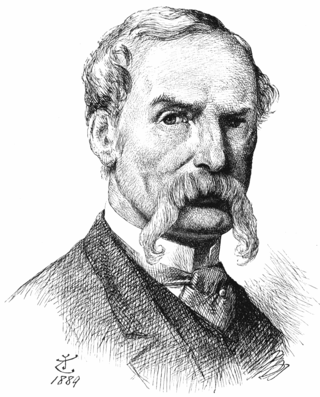
Sir John Tenniel was an English illustrator, graphic humourist and political cartoonist prominent in the second half of the 19th century. An alumnus of the Royal Academy of Arts in London, he was knighted for artistic achievements in 1893, the first such honour ever bestowed on an illustrator or cartoonist.

"Jabberwocky" is a nonsense poem written by Lewis Carroll about the killing of a creature named "the Jabberwock". It was included in his 1871 novel Through the Looking-Glass, the sequel to Alice's Adventures in Wonderland (1865). The book tells of Alice's adventures within the back-to-front world of the Looking-Glass world.

Through the Looking-Glass, and What Alice Found There is a novel published on 27 December 1871 by Lewis Carroll, a mathematics lecturer at Christ Church, University of Oxford, and the sequel to Alice's Adventures in Wonderland (1865). Alice again enters a fantastical world, this time by climbing through a mirror into the world that she can see beyond it. There she finds that, just like a reflection, everything is reversed, including logic.
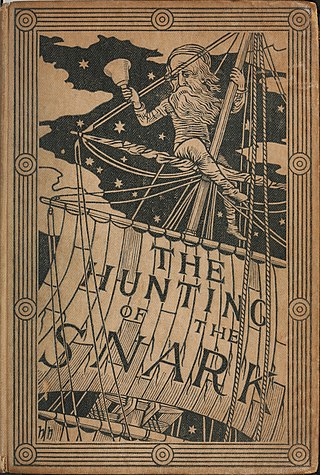
The Hunting of the Snark, subtitled An Agony, in Eight fits, is a poem by the English writer Lewis Carroll. It is typically categorised as a nonsense poem. Written between 1874 and 1876, it borrows the setting, some creatures, and eight portmanteau words from Carroll's earlier poem "Jabberwocky" in his children's novel Through the Looking-Glass (1871).

Alice's Adventures in Wonderland is an 1865 English children's novel by Lewis Carroll, a mathematics don at Oxford University. It details the story of a young girl named Alice who falls through a rabbit hole into a fantasy world of anthropomorphic creatures. It is seen as an example of the literary nonsense genre. The artist John Tenniel provided 42 wood-engraved illustrations for the book.
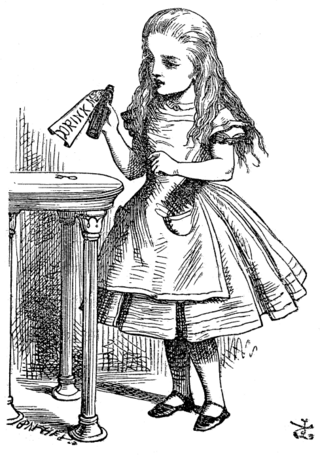
Alice is a fictional character and the main protagonist of Lewis Carroll's children's novel Alice's Adventures in Wonderland (1865) and its sequel, Through the Looking-Glass (1871). A child in the mid-Victorian era, Alice unintentionally goes on an underground adventure after falling down a rabbit hole into Wonderland; in the sequel, she steps through a mirror into an alternative world.

Alice Pleasance Hargreaves was an English woman who, in her childhood, was an acquaintance and photography subject of Lewis Carroll. One of the stories he told her during a boating trip became the classic 1865 children's novel Alice's Adventures in Wonderland. She shared her name with "Alice", the story's heroine, but scholars disagree about the extent to which the character was based upon her.
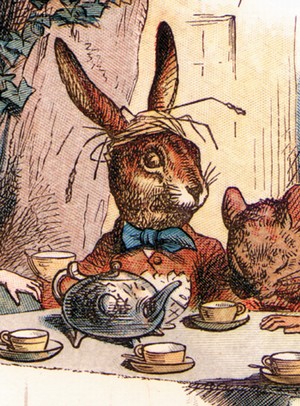
The March Hare is a character most famous for appearing in the tea party scene in Lewis Carroll's 1865 book Alice's Adventures in Wonderland.

Macassar oil is an oil that was originally compounded from Macassar ebony oil that was used primarily by Western European men throughout the 1800s and early 1900s as a hair conditioner to groom and style the hair.
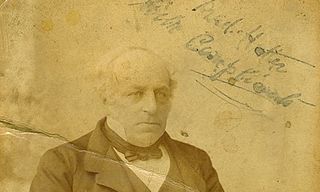
Theophilus Carter was an eccentric British furniture dealer who may have been an inspiration for the illustration by Sir John Tenniel of Lewis Carroll's characters the Mad Hatter in his 1865 novel Alice's Adventures in Wonderland and Hatta in the 1871 sequel Through the Looking-Glass.
The Lewis Carroll Society of North America (LCSNA) is a learned, not-for-profit organization dedicated to furthering interest in the life and works of the Rev. Charles L. Dodgson, known to the world as Lewis Carroll, through its publications, and by providing a forum for speakers and scholars, and helping collectors, students, and other Carroll enthusiasts connect with each other.

The Red Queen is a fictional character and the main antagonist in Lewis Carroll's fantasy 1871 novel Through the Looking-Glass. She is often confused with the Queen of Hearts from the previous book Alice's Adventures in Wonderland (1865), although the two are very different.

Alice from Alice's Adventures in Wonderland is one of the most iconic figures to emerge from 19th century children's literature, and one who is instantly recognized by her attire. Although many artists have depicted Alice in many different ways, the original illustrations by John Tenniel have become iconic through their subsequent repetition in most published editions and film adaptations.
"You Are Old, Father William" is a poem by Lewis Carroll that appears in his 1865 book Alice's Adventures in Wonderland. It is recited by Alice in Chapter 5, "Advice from a Caterpillar". Alice informs the Caterpillar that she has previously tried to repeat "How Doth the Little Busy Bee" and has had it all come wrong as "How Doth the Little Crocodile". The Caterpillar asks her to repeat "You Are Old, Father William", and she recites it.

Pat is a fictional character in Lewis Carroll’s 1865 book Alice's Adventures in Wonderland. He appears in the chapter "The Rabbit Sends in a Little Bill." He works for the White Rabbit like his friend Bill the Lizard. Carroll never gives any description of the character other than being a gardener, and his species has been widely debated, with evidence showing he is likely to be a monkey or a guinea pig.

Charles Lutwidge Dodgson, better known by his pen name Lewis Carroll, was an English author, poet, mathematician and photographer. His most notable works are Alice's Adventures in Wonderland (1865) and its sequel Through the Looking-Glass (1871). He was noted for his facility with word play, logic, and fantasy. His poems Jabberwocky (1871) and The Hunting of the Snark (1876) are classified in the genre of literary nonsense.
In a publishing career spanning 80 years (1930–2010), popular mathematics and science writer Martin Gardner (1914–2010) authored or edited over 100 books and countless articles, columns and reviews.

There are more than 100 illustrators of English-language editions of Alice's Adventures in Wonderland (1865) and Through the Looking-Glass (1871), with many other artists for non-English language editions. The illustrator for the original editions was John Tenniel, whose illustrations for Alice and Looking Glass are among the best known illustrations ever published.

Mark Burstein is an author, book editor and expert on the works of Lewis Carroll. He is a lifelong Carrollian and has been a key figure in the Lewis Carroll Society of North America (LCSNA).
Charlie Lovett is a bestselling novelist, bibliophile, podcast producer, children's playwright and expert on both the works and the life of Lewis Carroll. He has the world's largest collection of Carollean memorabilia and was twice president of the Lewis Carroll Society of North America.















